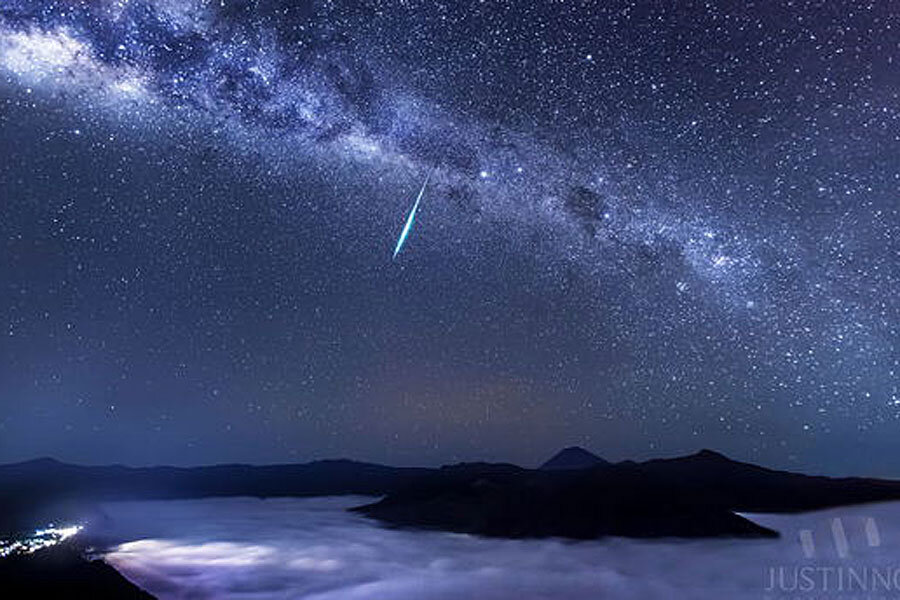Meteor shower: Halley's Comet showers Earth early Tuesday
Loading...
Early Tuesday morning (May 6), just before dawn begins to light up the eastern sky, stargazers have an opportunity to see a meteor shower made up of debris from one of the most famous of comets in history: Halley's Comet.
Halley's Comet made its last pass through the inner solar system in 1986 and it's not due back until the summer of 2061. Nonetheless, each time Halley sweeps around the sun, it leaves behind a dusty trail — call it "cosmic litter" — that ends up trailing behind the comet.
And as it turns out, the orbit of Halley's Comet closely approaches the Earth's orbit at two places. The first point comes now, in early May, producing the Eta Aquarid meteor shower. The other point occurs in the middle to latter part of October, producing a meteor display known as the Orionid meteor shower. [The 2013 Eta Aquarid Meteor Shower: Amazing Photos]
2014: A very good Aquarid year, but …
This year, the Eta Aquarid meteor shower is predicted to peak early on Tuesday morning, May 6, but will also be visible late at Monday night (May 5). Under ideal conditions (a dark, moonless sky) up to 60 of these very swift meteors might be seen per hour. The shower appears at about one-quarter peak strength for several days before and after May 6.
If bad weather or bright city lights spoil your view, you can watch webcasts of Eta Aquarid meteor shower Monday night, courtesy of NASA and the Slooh community telescope.
This year will be a very good year to watch for them because the moon will be one day from First Quarter phase which means it will have long since set when the stars of the constellation Aquarius make their appearance in the southeast sky during the early morning hours and will provide absolutely no interference to viewing these swift streaks of light.
There is, however, a bit of a catch.
What’s the point?
From places south of the equator, the Eta Aquarids put on very good show; Australians consider them to be the best meteor display of the year. But for those watching from north of the equator, it’s a much different story.
The radiant (the origin point of these meteors) is within the "Water Jar" of the constellation Aquarius, which begins to rise above the eastern horizon around 3 a.m. your local time, but unfortunately, never really gets very high as seen from north temperate latitudes. And soon after 4 a.m., morning twilight will begin to brighten the sky.
So if you're hoping to see up to 60 meteors per hour, forget it. With the radiant so low above the horizon, the majority of those meteors will be streaking below the horizon and out of your view. In fact, from North America, typical Aquarid rates are only 10 meteors per hour at 26 degrees north latitude (for Miami, Florida, or Brownsville, Texas); five meteors per hour at 35 degrees latitude (Los Angeles, California or Cape Hatteras, N.C.); and practically zero to the north of 40 degrees latitude (New York, Chicago, and Philadelphia).
"So," you might ask, "What's the point of getting up before dawn to watch?"
The answer: You might still see something spectacular.
Catch an earthgrazer
For most, perhaps the best hope is perhaps catching a glimpse of a meteor emerging from the radiant that will skim the atmosphere horizontally — much like a bug skimming the side window of an automobile.
Meteor shower watchers call such shooting stars "earthgrazers." They leave colorful, long-lasting trails. "These meteors are extremely long," says Robert Lunsford, of the International Meteor Organization. "They tend to hug the horizon rather than shooting overhead where most cameras are aimed."
"Earthgrazers are rarely numerous," cautions Bill Cooke, a member of the Space Environments team at the Marshall Space Flight Center. "But even if you only see a few, you're likely to remember them."
Comet crumbs
If you do catch sight of one early these next few mornings, keep in mind that you'll likely be seeing the incandescent streak produced by material which originated from the nucleus of Halley's Comet. When these tiny bits of comet collide with Earth, friction with our atmosphere raises them to white heat and produces the effect popularly referred to as "shooting stars."
So it is that the shooting stars that we have come to call the Eta Aquarids are really an encounter with the traces of a famous visitor from the depths of space and from the dawn of creation.
Editor's note: If you have an amazing picture of an Eta Aquarid meteor, or any other night sky view, that you'd like to share for a possible story or image gallery, send photos, comments and your name and location to managing editor Tariq Malik at spacephotos@space.com.
Joe Rao serves as an instructor and guest lecturer at New York's Hayden Planetarium. He writes about astronomy for Natural History magazine, the Farmer's Almanac and other publications, and he is also an on-camera meteorologist for News 12 Westchester, N.Y.Follow us @Spacedotcom, Facebook and Google+. Original article on Space.com.
- Amazing Night Sky Photos for May 2014 (Stargazing Gallery)
- Night Sky: Visible Planets, Moon Phases & Events, May 2014
- Best Beginner Astrophotography Telescopes
Copyright 2014 SPACE.com, a TechMediaNetwork company. All rights reserved. This material may not be published, broadcast, rewritten or redistributed.







